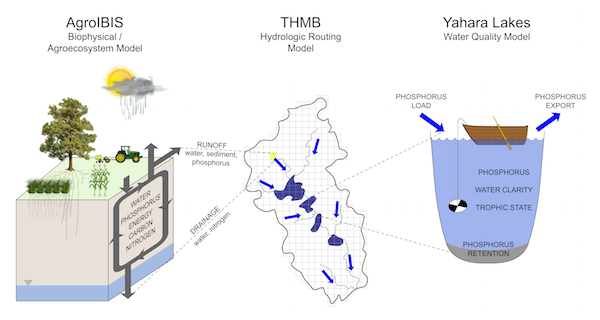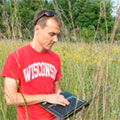research
EXPERTS
Christopher Kucharik
Professor
Agronomy, Nelson Institute Center for Sustainability and the Global Environment
Stephen Carpenter
Director, Center for Limnology and
Stephen Alfred Forbes Professor of Zoology
Eric Booth
Assistant Research Scientist
Agronomy and Civil & Environmental Engineering
Xi Chen
Postdoctoral Researcher
Melissa Motew
Environment & Resources, PhD
Evren Soylu
Postdoctoral Researcher,
Project Engineer LimnoTech
Biophysical Computer Models
WSC researchers used a suite of numerical models to assess potential future conditions for freshwater and other ecosystem services, based on the changes in climate, land use, and nutrient management that occur in the Yahara 2070 scenarios. The models are able to simulate ecosystem indicators such as lake water quality, crop production, water balance (i.e., the amount of water flowing into, out of, and within the watershed), groundwater recharge, and carbon uptake by plants and soils. Their results give insight into potential ecosystem health and human well-being in the future, as well as point to possible vulnerabilities to prepare for and opportunities to pursue.
Explore: Model results infographic
Read: Meeting Our Future Water Needs: Key lessons and opportunities, a summary of key insights from the model results
Model Innovations
WSC took an innovative approach to modeling ecological conditions with the following features:
- Groundwater simulation: We have introduced groundwater to our modeling framework so that we may study the role that groundwater plays within the watershed, such as how groundwater levels affect and respond to plant growth and changes in groundwater supply.
- Phosphorus cycling: We have added the capacity to simulate phosphorus cycling within our modeling framework. This allows us to investigate the effects of multiple drivers of change on surface water quality, including climate change and farm management practices.
- Lake water quality: WSC models will estimate water quality using existing models that are based on extensive long-term data on phosphorus and water quality.
- Holistic framework: A combination of models will provide a comprehensive assessment of the Yahara Watershed’s ecological conditions and processes. For issues of nonpoint source pollution, the framework will enable simulation from source to sink: from fertilizer application on croplands to the downstream effects on lakes.
The Modeling Suite

Agro-IBIS: Terrestrial Ecosystem Processes
Agro-IBIS is responsible for simulating terrestrial ecosystem processes. This includes the movement, or “cycling,” of energy, water, and nutrients (e.g., carbon, phosphorus and nitrogen) within soil, vegetation, and the atmosphere.
For example, Agro-IBIS can simulate the movement of water from the atmosphere (rain), to the soil, to plants growing in the soil, and back to the atmosphere through transpiration.
Agro-IBIS provides a way to track ecosystem processes over time. It can provide insight into how certain drivers of ecological change, such as climate and land use, affect ecological functions like plant growth and nutrient cycling.
THMB: Terrestrial Hydrology & Biogeochemistry Model
Based on the land’s topography, THMB simulates the flow of water, sediment, and nutrients through rivers, wetlands, lakes, and human-made reservoirs. Used together, Agro-IBIS and THMB can simulate the movement of water and nutrients from the landscape, through the stream network, and into a large water body, such as a lake. With MODFLOW, we can also incorporate changes in groundwater levels, enabling a more complete picture of the entire hydrologic system and allowing us to study the interactions between groundwater and vegetation.
YWQM: Yahara Water Quality Model
Yahara Water Quality Model (YWQM) uses the simulated flows of water, sediment, and phosphorus from Agro-IBIS/MODFLOW and THMB to project changes in lake water quality. Phosphorus degrades lake water quality by creating conditions conducive to eutrophication, which can lead to harmful algae growth. By including YWQM in the model suite, we can study how lake water quality might react to changes in climate, land use and land management.YWQM uses data provided by the North Temperate Lakes Long-Term Ecological Research program and the Wisconsin Department of Natural Resources.

RESEARCH HIGHLIGHTS
Meeting Our Future Water Needs: Key lessons and opportunities
Yahara 2070 model results infographic
Study quantifies role of 'legacy phosphorus' in reduced water quality
How to simulate the future of a watershed









